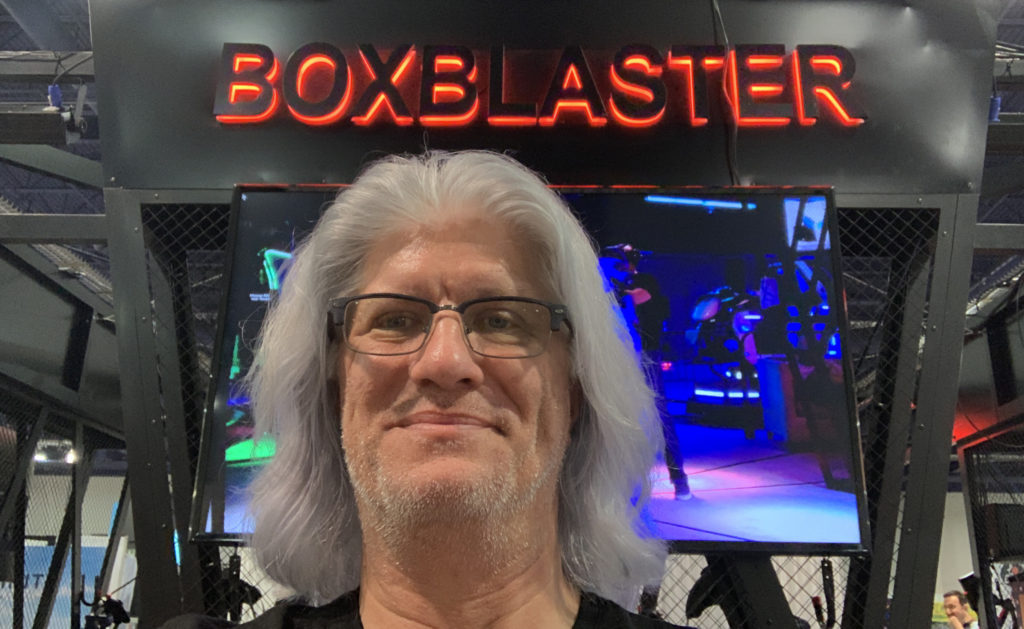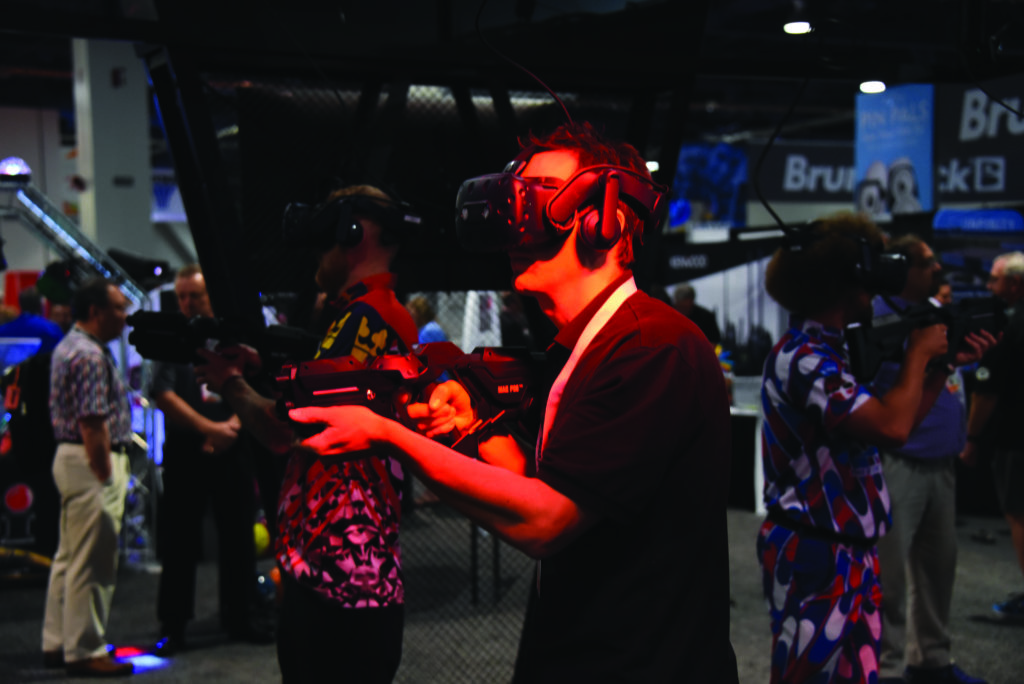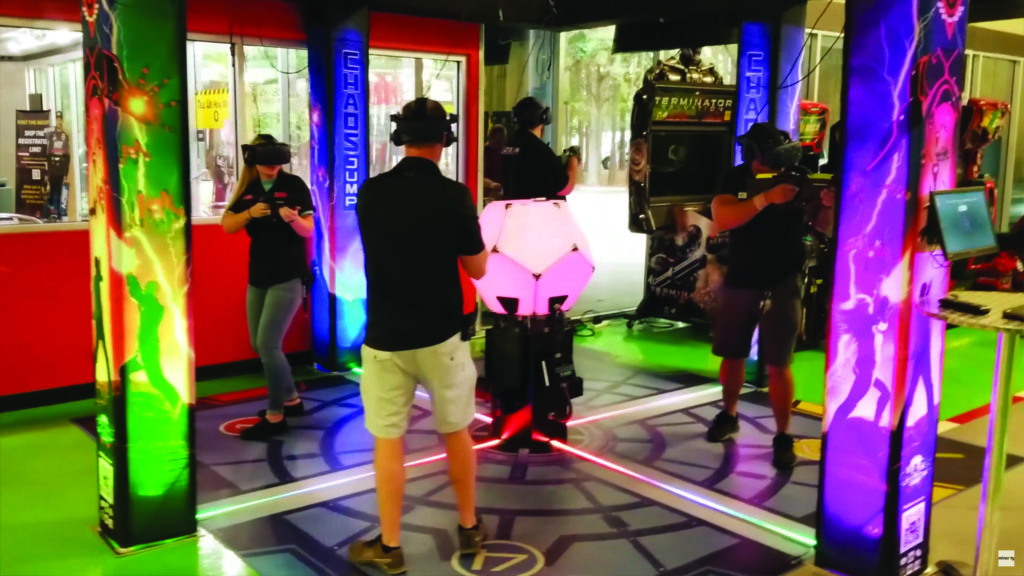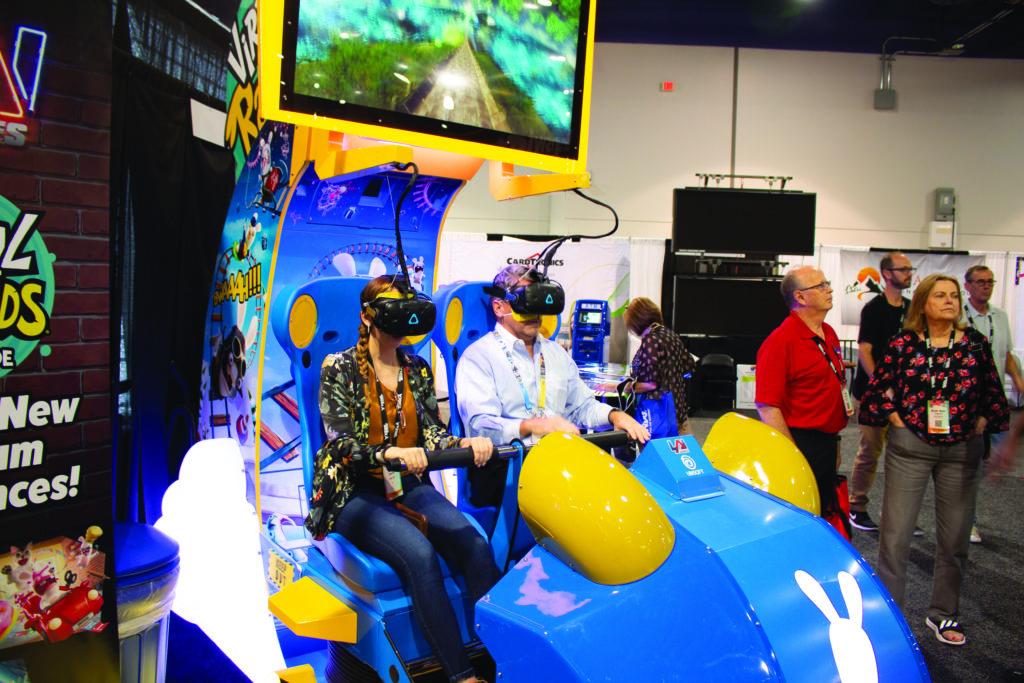
Virtual Reality on Stage at Bowl Expo
What Readers Need to Know About the VR Tech Displayed in Vegas
by Bob Cooney
Bowl Expo has morphed into a summer FEC show, attracting a wide variety of amusement operators. Many FECs are adding bowling as an anchor attraction, and bowling centers are continuing the trend of adding other attractions to stay relevant when interest in traditional bowling leagues is waning.
The interest in virtual reality attractions continues to grow both from operators and manufacturers. This third wave of VR seems to be overcoming the initial skepticism from operators that it might be a fad. It’s becoming a must-have attraction with operators graduating from “should I have VR?” to “what VR should I have?”
Large chains like Dave & Buster’s and Main Event are increasing their commitment to VR. Reports from the Bowl Expo show floor suggest the latter signed a significant purchase contract with Creative Works for multiple Hologates. Dave & Buster’s recently expanded their tests of VR with the Omni Arena from Virtuix and the free-roam Power Play from VR Studios. Both companies are testing multi-attraction VR arcades within their main arcade floor, as a means to build critical mass as well as better control labor costs.
This year’s Bowl Expo saw seven VR attractions on display, with a few more companies representing virtual reality products that did not showcase them. Here’s a quick rundown of what you might have missed. Let’s start with the newcomers.

Boxblaster
The company that seemed to generate the most buzz on the show floor was Boxblaster. Entering the increasingly crowded multi-player arcade segment, this startup from Miami brought a new industrial design, a library of five diverse games, and a unique business model that resonated with operators who have been on the fence about virtual reality as an investment.
Boxblaster’s Minibox looks a bit different than Hologate and its brethren. Eschewing the box truss for aluminum mesh and tube, the unit has a different feel about it. At 15 x 15 feet, it fits in between the 17 x 17’ Hologate and Minority Media’s relatively small 12 x 12’ Chaos Jump (which is still the most compact of the 4-player arcade systems). Still, black seems to be the new black, and I am looking forward to more family-friendly color schemes, ala Chaos Jump, entering the fray.
On day one, Boxblaster showcased their wave shooter games, Arcania and Eclipse, which feature gorgeous environments developed with Unreal Engine (a suite of tools used by game developers). Both games had a wonderful variety of enemies and weapon powerups. Arcania was clearly the more polished of the titles (the company claims that Eclipse is still in development) with well-balanced attacks and a variety of boss battles. Boxblaster claims to use AI to make the enemies more responsive to the player’s skill. I found Arcania to be challenging even on the third play.
On the second day of the show, Boxblaster showed sneak-peeks of some of the games still in development. One was a cute game called Dino Smash, inspired by Whac-A-Mole, where you have to cut fruit, smash crystals and catch fish with a net in a variety of levels. It was whimsical and fun, and shows great promise.
But for me, the VR hit of the show was a game with a working title of Gold and Mace. In it, players are in a cartoon-styled medieval land where tiny knights are being catapulted at them from somewhere in the distance. Players can catch them, tear them apart (with a very cute and non-offensive cartoon “pop”), throw them to destroy other enemies, smash them with a variety of weapons, and even skewer them on a spear.
The multiplayer aspect was not fully developed yet, but promised to add a competitive element where players can catch bombs and throw them at each other. It was the most innovative title I have seen in VR in a long time. I observed players of all ages and demographics on the show floor, and they found it intuitive and just plain fun. I think this game is going to be a huge hit when it ships later this year. It’s encouraging to think we are moving from just good tech demos into seeing great games developed for VR platforms. That’s what’s going to drive the market forward.
As good as that game was, the most innovative thing that Boxblaster brought to the show was its business model. Looking to activate the mainstream market, company execs recognize that many operators are still risk averse when it comes to making six-figure investments in virtual reality attractions. To overcome that concern, they were offering their Minibox for $45K (which they claim is their cost to manufacture the system) with a revenue share of 25 percent added on top.
In return for the revenue share, the company offers two or more new games per year, 24/7 support and hardware upgrades every two years. This latter benefit is worthy of discussion.
One of the things I have learned in building location-based network businesses is that the weakest link in your hardware chain determines the quality of the software you can deliver to your customers. At Ecast, where we had 10,000 digital downloading jukeboxes on the street, any update we put on the network had to run on the oldest hardware.
Virtual reality tech will continue to improve rapidly. In two years, what looks amazing today could easily look tired on the arcade floor. Keeping up with the obsolescence cycle isn’t just a matter of operators purchasing upgrades. Companies need to be developing their software to take advantage of the latest hardware. If the majority of the installed base is running old hardware, this would mean leaving existing customers behind. It’s a conundrum that typically leads to sub-par products in the field over time.
The beauty of the Boxblaster model, as I see it, is their entire installed base will always be running the latest technology, which means their new games will be developed on the same. Expect richer environments, better resolution, and higher frame rates, which will all lead to better customer experiences.
Only time will tell if the operator community embraces this model. A few told me that the 25 percent was too high, but when you consider a $50K discount compared to the cost of competing platforms, who also have annual license fees they tack on top or make operators purchase the games individually, it almost feels too low to me. Will the company be able to keep its commitment at that price level, or will they wind up increasing it over time?
Virtual Games Park
The other totally new company that popped up at Bowl Expo was Virtual Games Park. This French company was showcasing a large, free-roam system based upon the new Microsoft Mixed Reality platform. (This really isn’t a “mixed reality platform,” it’s a virtual reality platform, but whatever. Who names this stuff?) It’s the same hardware tech that Zero Latency unveiled recently at Amusement Expo. Featuring a combination of headset and backpack from HP, the “inside/out” tracking doesn’t require lots of cameras mounted around the playing space like the older systems, reducing the cost and increasing the reliability.
The democratization of VR tracking technology is enabling companies to bring products to market faster and cheaper than ever. This reminds me of the mid-’90s in the laser tag business, when every engineer with a garage seemed to be at IAAPA selling laser tag equipment. From 1991, when Laser Storm and Q-Zar debuted, to 1996, no less than 18 laser tag companies popped up. Expect to see more of that in the VR market in the next couple of years.
Unfortunately, it takes more than the ability to buy backpacks and headsets to bring a quality VR experience to market. And Virtual Games Park has a lot to learn. The games were just not up to the emerging standards from the other companies in this space, and this was not just my opinion but that of several others that I spoke to. Hopefully they got that message and will go back to the drawing board, because this is a crowded market and you need to bring quality at this stage.

Minority Media
There were also companies at Bowl Expo that were following up their IAAPA and Amusement Expo debuts. Minority Media had a breakout show, fresh off their announcement that Betson was going to be representing them. True to their word, for two days the Chaos Jump booth was packed with Betson sales reps and their customers. They were showing off their new player-vs-player (PvP) game, Reclaim!
PvP is a new craze you’re hearing a lot about these days in the VR market. It’s leveraging the buzz around esports and the history of laser tag. It pits players against each other, either individually in a free for all, or in teams. Reclaim! is a free-for-all game where players pick from three different classes of avatars: the Tank, the Ninja or the Warrior. They each have different attributes like speed, firepower or shields. Players can match their playing style to the avatar class making the game more enjoyable. It’s these types of features that are the hallmark of Minority Media, and it’s what makes their games stand out from the pack.
Players teleport around the playing field, ducking for cover, and shooting opponents with a combination of lasers and bombs. I played with three other first timers and had to tone my game down a bit to make sure everyone had fun. And they did. There was laughing and screaming and the kind of trash talk that happens among friends when everyone is enjoying themselves.
PvP games are hard to do well. The balancing of the games is extremely difficult. Even back in my Laser Storm days we had the challenge of expert players coming in and using the newbies for target practice. It created a frustrating experience for new players, who then would not want to play again. Lots of operators think that PvP is the answer to repeat play, and in theory I agree. But in practice, it’s much harder than it seems. There are few great PvP games out there, and I count Reclaim! as one of them.
Hologate
Hologate was back in the Creative Works booth, and I was hoping to get a demo of the new Angry Birds game, which has been promised in advance of the Angry Birds 2 movie release on August 16, but there’s no sign of it yet. Hologate announced at IAAPA it would be shipping a multiplayer version of the blockbuster mobile game that had more than 2 billion downloads and a global box office for the first movie spinoff of $350 million. It’s a premium title that will come with another new business model. Word is that operators will be asked to prepay a fixed price per play by purchasing tokens that will unlock the game for consumers. No word yet on the actual price or how many you will need to buy.
Talking to operators who currently run Hologate, there are mixed expectations as to whether a major IP will actually drive higher revenue to justify the higher per game pricing. We are all still learning at this stage, and as soon as it ships, we will find out.
Vex
Vex followed up its successful debut at Amusement Expo showing a new game Temple Quest. Clearly inspired by Zero Latency’s Engineerium game, players explore an ancient civilization in what might best be described as a puzzle game. Operators keep clamoring for games that don’t involve shooting zombies, and this is clearly an attempt to fill that need. I can tell you that although Engineerium won a coveted best product at IAAPA for Zero Latency, it never took off as a popular title. Puzzle games are hard to sell to consumers. The only thing people seem to like more than than shooting zombies is shooting their friends.
For those who have not seen Vex, it stands out from the competition by including environmental and physical haptics and full-body tracking in a compact footprint. Just a little bigger than Hologate, Vex attempts to bring an experience that’s on-par with The Void for about 10 percent of the cost. It’s a high-end experience, that should come with a higher consumer price point. Games run about 25 minutes and the equipment is quite heavy. It’s not for kids, but if you’re targeting Millennials it’s worth your consideration. The product is being sold in the U.S. by ARC-Studios.

LAI Games
LAI was celebrating its 500th installation of Virtual Rabbids: The Big Ride (see photo top left) and showcasing the newest titles for the breakout arcade hit. Three new adventures are hoping to extend what has been fantastic earnings for operators for at least another year. Coaster Calamity is an extreme roller coaster experience, similar to the original. New twists come in the form of Kitchen Calamity where you are miniaturized and “drive” a toy car through a kitchen, trying to escape from a Rabbid Chef. And finally, Space Skirmish adds an interactive target shooting element. I didn’t try the new games because motion sims make me want to barf. But research shows kids are much less prone to simulator sickness, and earnings don’t lie. There’s a reason LAI made Virtual Rabbids the most successful location-based VR product in the industry.
Major Mega
Major Mega came to Bowl Expo hoping to stoke some interest in its HyperDeck platform that debuted at IAAPA. Still in development but getting ready to make a debut at a theme park in the northeast U.S. later this year, the 4-player ride/game hybrid platform is at the premium end of the spectrum and is priced accordingly. I tried an early build of their first game in Orlando and loved it. They employ extreme wind, heat and motion with a high level of recoil in the weapon to really deepen the immersion. When motion is done right, it’s powerful, and to my surprise, I never felt a bit of unease in the HyperDeck.
Their game, where players ride a steampunk heavily armed recreational vehicle through a Mad Max landscape battling an egomaniacal ’80s hair metal rock god, was equal parts fun and hilarious. Unfortunately, they did not bring the full product to Bowl Expo, only the controller mechanism, but even that showcased the quality of the build and design.
HyperDeck is most likely to be priced at $200K or more, so it’s not for every arcade. Many operators were choking on that price point, but for the right location looking for a highly differentiated anchor attraction –– and with a willingness to charge a premium price –– it could work.
If you’re considering surfing this third wave of virtual reality and are trying to figure out what the ideal VR attraction is for your location, I have been writing a series of blog posts on that subject. I’ve created an evaluation framework any operator can use to help them with the selection process.
For more information, go to www.bobcooney.com/blog.
Electronic gaming and location-based entertainment veteran Bob Cooney helps companies with virtual and augmented reality solutions develop strategies to bring their products to the location-based entertainment market. He also helps operators navigate the stormy seas of disruption to select the best virtual reality solutions and experience for their locations. Bob has over 25 years of experience designing, manufacturing and marketing immersive out-of-home entertainment to consumers, operators and venues –– first as founder and chief executive of NASDAQ- and Inc. 500-listed Laser Storm, and later as an initial member of the Global VR executive team which introduced the first commercially viable virtual reality arcade game. Cooney went on to become VP of marketing and business development of Ecast, the digital content provider for jukeboxes, and COO of NTN Buzztime, the networked trivia game company. Cooney has been a driving force behind the development of numerous top-earning licensed games, including products based on EA Sports PGA Tour, X-MEN and Stargate, and has been a long-time vocal proponent of leveraging new technology to keep the out-of-home amusement industry relevant. To get in touch with Bob, visit www.bobcooney.com or email vrbob@bobcooney.com.
